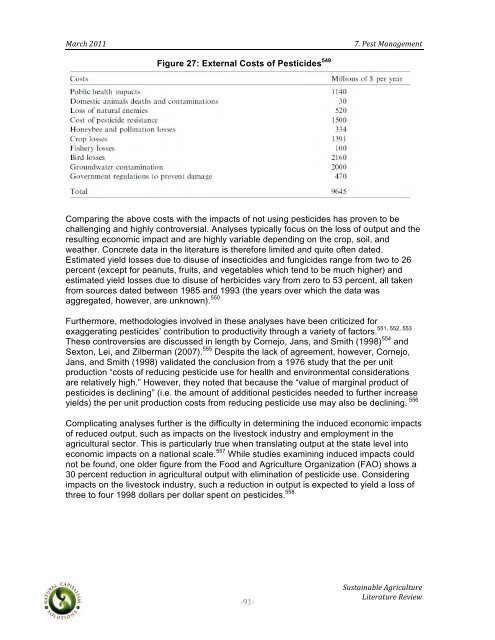Sustainable Agriculture Literature Review - Boulder County
Sustainable Agriculture Literature Review - Boulder County
Sustainable Agriculture Literature Review - Boulder County
You also want an ePaper? Increase the reach of your titles
YUMPU automatically turns print PDFs into web optimized ePapers that Google loves.
! ! !!<br />
"#$%&!'())!! !!!!!!!!!!!!!!!!!!!!!!!!!!!!!!!!!!!!!!!!!!!!!!!!!!!!!!!!!!!!!!!!@+!A142!"#5#81B152!<br />
!<br />
Figure 27: External Costs of Pesticides 549<br />
Comparing the above costs with the impacts of not using pesticides has proven to be<br />
challenging and highly controversial. Analyses typically focus on the loss of output and the<br />
resulting economic impact and are highly variable depending on the crop, soil, and<br />
weather. Concrete data in the literature is therefore limited and quite often dated.<br />
Estimated yield losses due to disuse of insecticides and fungicides range from two to 26<br />
percent (except for peanuts, fruits, and vegetables which tend to be much higher) and<br />
estimated yield losses due to disuse of herbicides vary from zero to 53 percent, all taken<br />
from sources dated between 1985 and 1993 (the years over which the data was<br />
aggregated, however, are unknown). 550<br />
Furthermore, methodologies involved in these analyses have been criticized for<br />
551, 552, 553<br />
exaggerating pesticides’ contribution to productivity through a variety of factors.<br />
These controversies are discussed in length by Cornejo, Jans, and Smith (1998) 554 and<br />
Sexton, Lei, and Zilberman (2007). 555 Despite the lack of agreement, however, Cornejo,<br />
Jans, and Smith (1998) validated the conclusion from a 1976 study that the per unit<br />
production “costs of reducing pesticide use for health and environmental considerations<br />
are relatively high.” However, they noted that because the “value of marginal product of<br />
pesticides is declining” (i.e. the amount of additional pesticides needed to further increase<br />
yields) the per unit production costs from reducing pesticide use may also be declining. 556<br />
Complicating analyses further is the difficulty in determining the induced economic impacts<br />
of reduced output, such as impacts on the livestock industry and employment in the<br />
agricultural sector. This is particularly true when translating output at the state level into<br />
economic impacts on a national scale. 557 While studies examining induced impacts could<br />
not be found, one older figure from the Food and <strong>Agriculture</strong> Organization (FAO) shows a<br />
30 percent reduction in agricultural output with elimination of pesticide use. Considering<br />
impacts on the livestock industry, such a reduction in output is expected to yield a loss of<br />
three to four 1998 dollars per dollar spent on pesticides. 558<br />
"$'"<br />
!,342#.5#6/1!78$.%3/23$1!<br />
9.21$#23$1!:1;.1
















